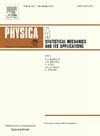加密网络
IF 2.8
3区 物理与天体物理
Q2 PHYSICS, MULTIDISCIPLINARY
Physica A: Statistical Mechanics and its Applications
Pub Date : 2024-09-25
DOI:10.1016/j.physa.2024.130128
引用次数: 0
摘要
实证文献对加密货币市场的联系进行了研究,因为了解冲击如何从一种货币传递到另一种货币,有助于政策制定者和从业者更好地应对冲击在这些市场和相关市场的传播。本文提出了一种基于格兰杰因果关系和网络分析的方法,为这一文献做出了贡献。利用 2018-2023 年期间 22 种加密货币的每日对数收益率,我建立了一个 VAR 模型来推断加密货币之间的单向或双向格兰杰因果关系。然后将这些关系转化为有向网络,并计算出若干中心度量。为了了解加密货币网络的动态,我们还对这些中心度量进行了多年观察。我发现,特征中心度每增加一个单位,对数回报率就会增加 0.22%。加密货币是非垂直连接的,在本样本中,Cardano、Dogecoin、Gridcoin 和 Neo 是整个期间网络中最中心的加密货币。一些加密货币(如 Dogecoin 或 Neo)的中心地位逐年下降,而其他加密货币(如 Gridcoin、莱特币、Namecoin 或 Ripple)的中心地位则不断上升。这些结果支持了加密货币市场不再只与比特币相关联的观点,并为进一步研究金融市场的冲击传播奠定了基础。本文章由计算机程序翻译,如有差异,请以英文原文为准。
Crypto network
The empirical literature has studied linkages in the cryptocurrency market because knowing how shocks pass from one currency to another helps policymakers and practitioners better counter their propagation in these and related markets. This paper contributes to this literature by proposing a methodology based on Granger causality and network analysis. Using the daily log-returns of 22 cryptocurrencies over the period 2018–2023, I develop a VAR model to infer unidirectional or bidirectional Granger causality among cryptocurrencies. These relationships are then transformed into a directed network and several centrality measures are calculated. The centrality measures are also observed over the years to understand the dynamics of the cryptocurrency network. I find out that each one unit increase in eigencentrality is associated with a 0.22 percent increase in log-returns. Cryptocurrencies are nontrivially connected, and in this sample Cardano, Dogecoin, Gridcoin, and Neo are amongst the most central in the network throughout the period. Some cryptocurrencies, such as Dogecoin or Neo, show decreasing centrality over the years, while others, such as Gridcoin, Litecoin, Namecoin, or Ripple, gain centrality. These results support the idea that the cryptocurrency market is no longer exclusively associated with Bitcoin and lay the groundwork for further study of shock propagation in financial markets.
求助全文
通过发布文献求助,成功后即可免费获取论文全文。
去求助
来源期刊
CiteScore
7.20
自引率
9.10%
发文量
852
审稿时长
6.6 months
期刊介绍:
Physica A: Statistical Mechanics and its Applications
Recognized by the European Physical Society
Physica A publishes research in the field of statistical mechanics and its applications.
Statistical mechanics sets out to explain the behaviour of macroscopic systems by studying the statistical properties of their microscopic constituents.
Applications of the techniques of statistical mechanics are widespread, and include: applications to physical systems such as solids, liquids and gases; applications to chemical and biological systems (colloids, interfaces, complex fluids, polymers and biopolymers, cell physics); and other interdisciplinary applications to for instance biological, economical and sociological systems.

 求助内容:
求助内容: 应助结果提醒方式:
应助结果提醒方式:


